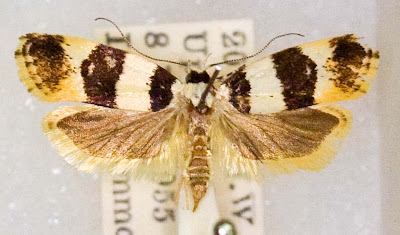Lichenaula arisema Meyrick, 1890
Lichenaula arisema, ANIC
Lichenaula arisema Meyrick, 1890, Descriptions of Australian Lepidoptera. Part I. Xyloryctidae. Transactions of the Royal Society of South Australia 13: 23–81 [48]. Syntype(s) BMNH 3♂♀, Sydney, NSW; Mt Lofty, SA.
Lichenaula arisema Meyr. Lower, 1896: A catalogue of Victorian Heterocera. Part xix. The Victorian Naturalist, 12: 149-152 [150].
Lichenaula arisema Meyr. Turner, 1898. The Xyloryctidae of Queensland. Annals of the Queensland Museum 4: 1–32 [20].
Lichenaula arisema Meyrick, 1890. Common, in Nielsen, Edwards, & Rangsi, 1996, Checklist of the Lepidoptera of Australia. Monographs on Australian Lepidoptera, 4: i-xiv, 1-529 & CD-ROM [87].
Lichenaula arisema Meyrick, 1890. Beccaloni, G. W., Scoble, M. J., Robinson, G. S. & Pitkin, B. (Editors). 2003. The Global Lepidoptera Names Index (LepIndex). World Wide Web electronic publication. http://www.nhm.ac.uk/entomology/lepindex [accessed 18 September 2019].
Lichenaula arisema Meyrick, 1890. Edwards, E. D. (2003), Xyloryctinae. Australian Faunal Directory. Australian Biological Resources Study, Canberra. http://www.environment.gov.au/biodiversity/abrs/online-resources/fauna/afd/taxa/XYLORYCTINAE [accessed 18 June 2010].
Original description, Meyrick 1890
Lich arisema, n. sp.
Both sexes 13-16 mm. Head white, crown blackish-fuscous. Palpi white, base dark fuscous. Antennae white, annulated with dark fuscous, ciliations in male 1/2. Thorax white, sometimes yellowish- tinged, posterior extremity dark fuscous. Abdomen dark-grey, sides and apex whitish-yellowish. Legs whitish, anterior and middle pair banded with dark fuscous. Forewings elongate, costa gently arched, apex tolerably rounded, hindmargin obliquely rounded; 7 to hindmargin; whitish-ochreous or white; three moderately broad nearly straight blackish· fuscous fasciae; first almost basal; second slightly curved, from middle of costa to beyond middle of inner margin, posterior edge sometimes with a short central projection; third hindmarginal, extending from apex almost to anal angle, narrowed to a point beneath, anterior edge sometimes angulated so as almost to touch preceding fascia in middle: cilia whitish-yellowish, with a, dark fuscous line, sometimes somewhat mixed with dark fuscous except on anal angle. Hindwings, dark-grey; cilia whitish-yellowish, sometimes with a grey line.
Sydney, New South Wales; Mount Lofty, South Australia; three specimens in November and December.
Other references
L. arisema, Meyr. (Tr. Roy. Soc, S.A., 48, 1889).
Gisborne, Hamilton. (Lower, 1896).
Lichenaula arisema, Meyr. Meyrick, 48.
near Brisbane: one specimen on New Year's Day. (Turner, 1898).
Diagnosis:
Description:
Head:
Thorax:
Abdomen:
Lichenaula arisema, male genitlia. 11ANIC-09774 (BOLD:AAY5255)
Dissected by Patrick Strutzenberger. ©BOLD
Lichenaula arisema, clasper. 11ANIC-09774.
Lichenaula arisema, uncus and gnathos. 11ANIC-09774.
Lichenaula arisema, anellus, saccus and juxta. 11ANIC-09774.
genitalia. 11ANIC-09772 (BOLD:AAY5255)
Dissected by Patrick Strutzenberger. ©BOLD
Lichenaula arisema, signum. 11ANIC-09772
Food plants:
Flight period: November, December.
Distribution: New South Wales, South Australia, Victoria. Endemic. (Edwards, 2003).
Remarks: Possibly the same species as Telecrates melanochrysa (Turner, 1939). It is noted that the male genitalia have a resemblance to those of Telecrates laetiorella.
"Lichenaula sp. nr. arisema"
Lichenaula sp. nr. arisema, ANIC.
Lichenaula sp. nr. arisema, ANIC.
Differs in that the ground colour of the wings is whitish, not yellow. This may simply be a colour variation of Lichenaula arisema.
Lichenaula sp. nr. arisema, female genitalia.
Lichenaula sp. nr. arisema, signum.
Updated 18 September 2019.












